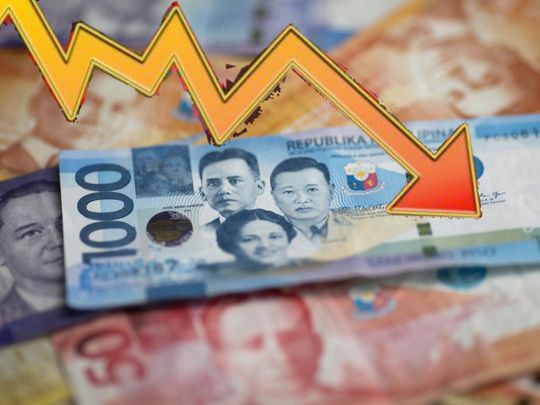
Manila: The Philippine peso dropped to an all-time record of Php57.57 against the US dollar on Friday (September 16, 2022) hitting multi-year lows alongside the currencies of its Asian neighbours.
There seems to be no floor in sight for how low the peso can go amid a broader international currency turmoil — as the greenback’s rally continues against major currencies across the globe.
Bangko Sentral ng Pilipinas (BSP) data show that the dollar-peso exchange rate has averaged 50.142 in September 2021, and has so far averaged Php56.876 this month (September 2022).
On Friday, the Philippine central bank sold US dollars at Php57.40 and bought at Php56.90, its reference exchange rate bulletin shows.
That sets a fresh record, beating the level hit in October 2004 — at Php56.45 versus the US dollar, when then-president Gloria Macapagal Arroyo declared a fiscal crisis.
Why does the US dollar keep appreciating?
There are a number of reasons: the big one is that the US Federal Reserve has been raising policy rates in its own fight against red-hot inflation in the US.
A rise in US interest rates makes US bond and debt markets even more attractive to international investors. Among those lending to the US government (in the form of Treasury bill purchases), higher interest rates mean greater returns from one of the most secure investment instruments in the world, as repayment of principal, plus interest, is guaranteed by taxpayers.
Supply and demand
The dollar’s rise against the peso and other currencies is also a supply-and-demand equation. As the demand for the US dollar rises, due to the attractiveness of dollar-denominated debts, other currencies become less attractive, including the PHP.
Since the start of January 2022, the PHP lost more than 12% of its value against the US$ — and posted a 13.43% drop year-on-year.
Next BSP meeting
The BSP, whose next policy rate-setting meeting is due on September 22, may announced a much higher rate hike this time, thus making the peso attractive to investors, at least for little while.
Since May, the BSP has increased policy rates by 175 basis points, as a policy lever to curb racing inflation, mostly triggered by fuel price hikes.
• Central banks tend to focus on one “policy rate” — generally a short-term, often overnight, rate that banks charge one another to borrow funds.
• When the central bank puts money into the system by buying (borrowing) securities, also known as “loosening” policy, the rate declines.
Dollar is safest hedge, for now
In general, economists see an “inverse” relationship between US currency and risk assets, including stocks.
Given that global equities have already lost $23 trillion in value this year — a sign that investors are dumping stocks in favour of debt market — the US dollar's surge3 is now the only possible safe harbour amid the storm brought by the biggest drop in shareholder value since a global financial crisis.
Moreover, the geopolitical backdrop continues to favour the greenback as a safe-haven currency, possibly for the rest of 2022, say analysts.
The Fed will meet on September 20-21 to review policy, and markets expect another aggressive increase amid the red-hot inflation in the US. Since March 2022 the Fed has raised rates by 225 basis points, including 75 basis points increases each in June and July.
According to the Bloomberg Dollar Spot Index, the US currency has risen more than 11% this year against 10 other global currencies. Still, all signs indicate that the US dollar is set for a record annual performance based on data compiled by Bloomberg since 2004.
Other Asian currencies slide
Several Asian currencies have already hit multiyear lows. The Chinese yuan slid past the psychological-important seven-per-dollar level, even as expectations of a big US federal reserve rate increase next week bolstered US treasury yields and kept the dollar demand robust.
The Chinese yuan had fallen below seven-per-dollar only twice since the global financial crisis on 2008 — a level seen by analysts as a possible trigger for capital outflows.
Thailand’s currency, the baht, also dropped to a level not seen since December 2006, while the Taiwanese dollar slipped to its lowest since September 2019.
The South Korean won hit a fresh 13-1/2 year low low, making it the worst-performing emerging market currency in Asia so far this 2022.
Analysts warned that defending currency levels is very costly and, if unilateral, is unlikely to work — at least for now, as the dollar remains on a very strong footing, which is hard to go against.
On Friday South Korean finance ministry official said the government would meet with major exporters any porters early next week to prepare measures to stabilise a dollar–won currency market.












